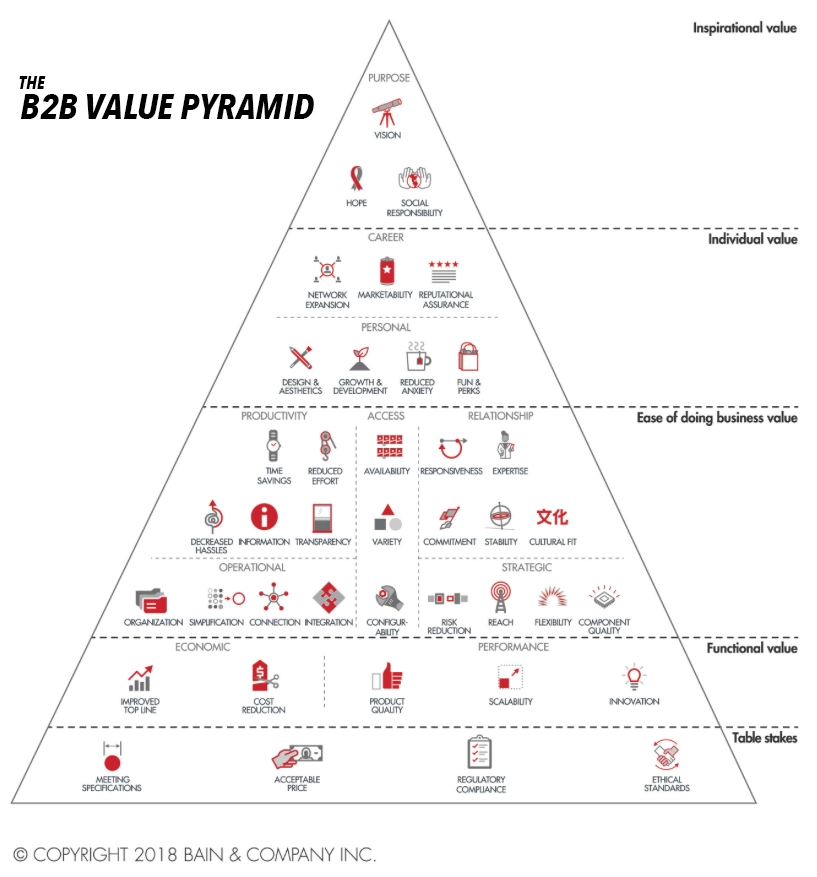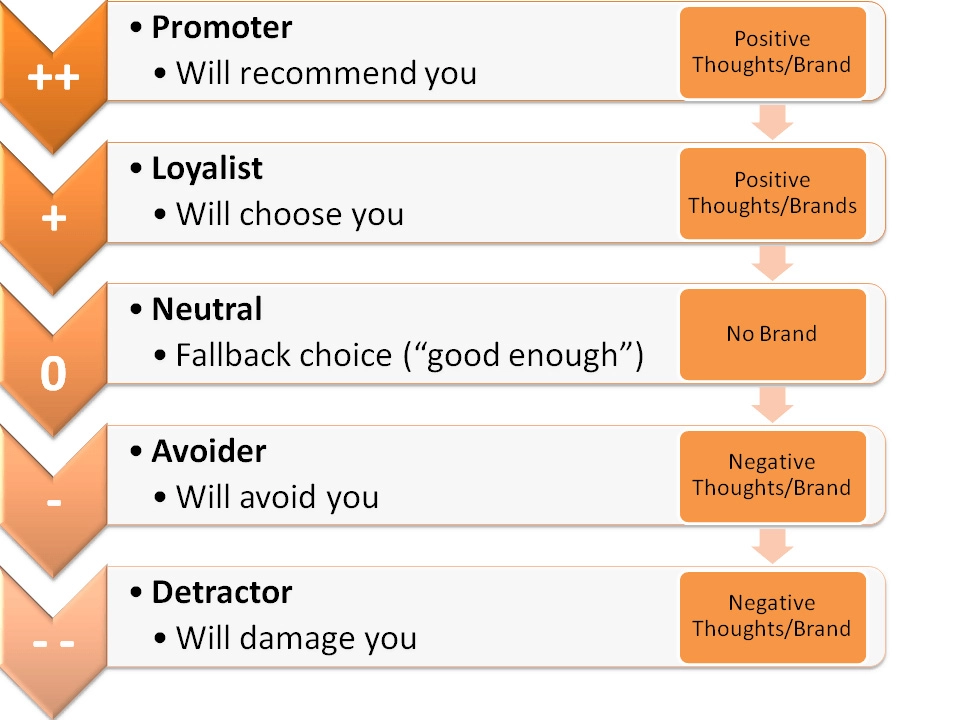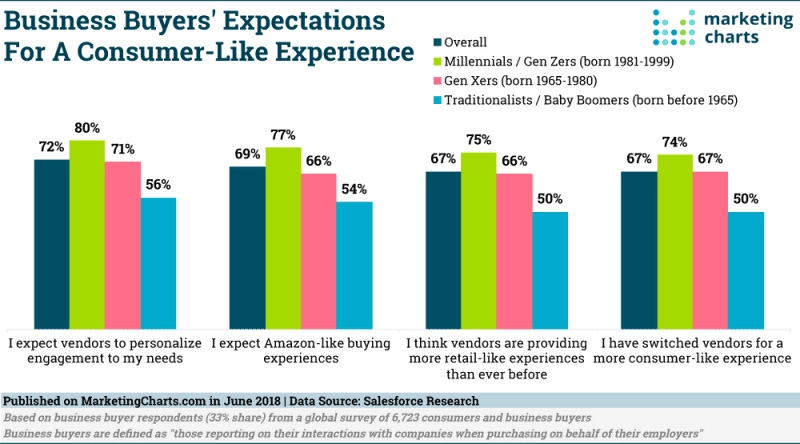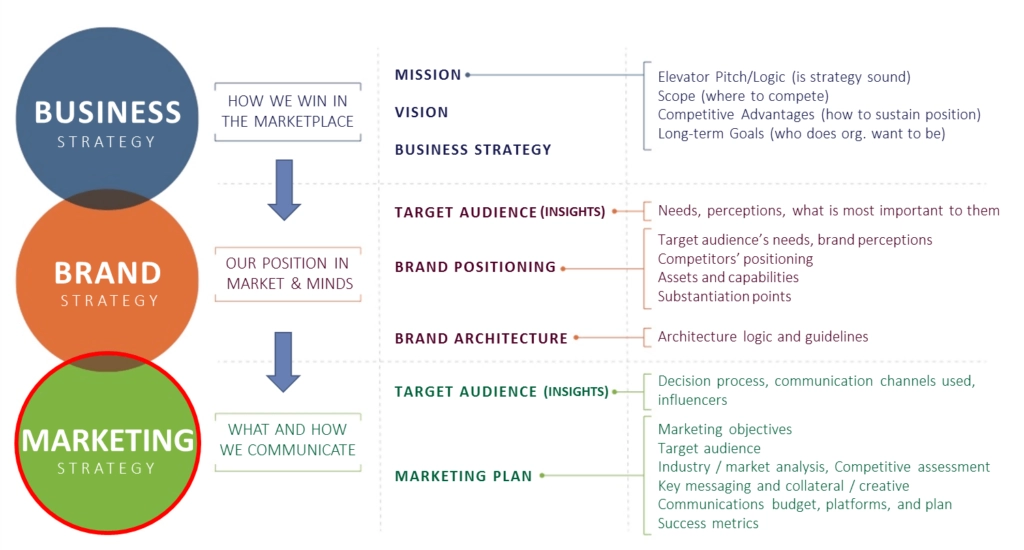
Introduction
As a B2B company, your brand is the sum total of everything that you do as perceived by the people that you seek to motivate. It is the experience that you create at all touchpoints before and after the sale. In fact, 65% of U.S customers say that great advertising is less relevant to them than a positive brand experience.
Today, customers and potential customers are aware of the different things that you do as a business, and these things factor into their buying decision. As such, a strong brand is one that provides a consistent experience that appeals to a large group of people, whether they are customers, potential customers or not.
For instance, it is well known that B2B sales-people have a significant stake in creating a brands perception. A consistent brand experience from all the sales-people when approaching potential clients would create a strong brand perception. If each sales-person does not reinforce the same core idea or values, then this weakens the perception of the brand.
What is B2B Branding?
Branding, is, therefore, more than just about design, symbol, name, advertising, SEO, or any of the other individual parts that you may think about. It is the sum total of all the impressions that a customer has, based on interactions between you, your products and your company. The brand speaks volumes about a company’s culture and overall strategy. It can be defined as the process of building a unique image in the customer’s mind.
 Figure1: B2B value pyramid
Figure1: B2B value pyramidB2B branding makes it easier for buyers to make decisions about the different choices that are open to them. This is especially the case when the options are overwhelming. Some of the critical attributes that B2B branding communicates include:
- This is an attribute that determines the value that others assign to your brand. Excellent customer experience is an example of a differentiator that provides brands with a significant competitive advantage that drives new sales. In fact, it is predicted that by 2020, a great customer experience will be a more significant differentiator than product and price. The more you can differentiate your brand and demonstrate how unique it is from your competitors, then the higher the price that your products can command. Differentiation is about showing what makes you better or why customers should choose you.
- Most companies don’t have to put much effort into demonstrating what they do and how they do it. However, having a cohesive narrative for why you do what you do makes all the difference when building a brand.
- Customer understanding. Communicating that your brand understands its customers and responds to their needs is critical especially for B2B brands whose relationships are more of a partnership than a customer-vendor relationship.
- When there is a lot of revenue/expenditure on the line, as is the case with most B2B relationships, brand consistency, as well as the entire purchase experience and consumption of the product, have paramount importance to the customer. Brand consistency means having the same core message when communicating across channels including in all conversations and in the experience that you create for your customers.
- Company culture guides customer relationships and determines how employees interact and engage with customers. If you care for customers and share their values, then your customers will trust that you are more committed to continuously solving any problems that arise because they understand that you are in with them for the long haul.
Why Does B2B Branding Matter?
In short, logic and policy are usually not enough to help you to create strong, trusting, and long-term relationships, that ultimately lead to sales and advocacy, as much as branding does.

Figure 2: How branding can affect customer relationships
When branding is done the right way by B2B companies, it can be used to create emotional connections, familiarity, trust, and loyalty which are all key ingredients that positively impact relationships and sales. This is why it is better to focus on your branding first and then on B2B marketing and sales. It makes B2B marketers and sales peoples jobs a lot easier and more productive.
That said, here are some concrete reasons why branding matters for B2B companies.
1. Branding Influences Trust In a Company
One of the primary benefits of branding is that it influences people to trust a company and, therefore, make a decision to work with the company which ultimately leads to sales. With branding, the sales process is more streamlined, and there is less opportunity for a prospect to disengage from the marketing or sales funnel.
Branding has the effect of impacting people’s emotions through images and story-telling which all have a more substantial impact than logical or rational thinking.
2. Branding Sets Up Upselling
Through cooperation, customers learn a company’s best practices and find out how they can better themselves through the brand’s expertise. All of this is set up through branding which creates a unique story and angle that draws like-minded buyers to work with the brand.
For example, B2B leads, and buyers, usually receive high-quality services and perks such as education, emotion, and experience which help them to learn and evolve with a brand. The net effect is that leads and customers become more invested in the B2B sellers’ products which in turn leads to sales, loyalty, and more importantly advocacy. In fact, B2B businesses that build relationships with their customers find that trust grows alongside spend and, eventually, loyal customers spend 67% more than new customers.
3. Branding Creates Familiarity Which Enables Faster Purchase Decisions
When there are lots of high-quality products to choose from, the buyer often goes with the choice that has the best branding. Essentially, the brand that has an attractive personality, charming story, and compelling values that align with those of the buyer, will always win because little effort goes into the purchase decision. In essence, once a potential buyer is familiar with a brand and is compelled by the brand, the deal is sealed faster.
4. Branding Secures Market Positions
B2B companies that make a name for themselves through branding don’t have to fear losing out to competition as much as companies that have not built a strong brand for themselves. Brand building provides enough incentive for customers (and potential customers) to be drawn to a brand, stay on as customers, and not look elsewhere due to brand loyalty. According to McKinsey, satisfied customers are more likely to purchase more and are less likely to cancel what they have already purchased.
5. Branding Sets You Up for Future Sales
Playing the long game and setting up future sales is a strategy that a lot of companies fail to consider. Through proper branding, a B2B company ensures that they draw in leads that will purchase right away, and makes sure that they keep buying a long time into the future. If a B2B company builds strong credibility by creating a strong brand, and thereafter, not only delivers on all promises but also surpasses expectations, this sets up easier future sales.

Figure 3: B2B buyers expect a consumer-like experience
6. Branding Sets Up Customer Expectations
Before starting a marketing campaign, considering brand management and best practices is crucial. Everything from content marketing, search-engine marketing, email marketing, and social media marketing should be cohesive in some way. Ensuring that brand identity is consistent by paying attention to brand guidelines that define image quality, layouts, fonts, colors, etc. creates a unique and recognizable impression in a buyer’s mind.
Staying on point conceptually and visually speaks to the reliability of a brand and sets the right expectations from the very first interaction and throughout the marketing/sales funnel, to the point when the deal is closed and after.
How to Build Your Brand?
Decision makers need to have trust and confidence in the brands that they work with. The branding strategy needs to be integrated into the B2B marketing strategy at all points to create the necessary trust and confidence that will consistently grow sales. Customer experiences can be managed by training employees and providing resources required to be aligned. In doing so, you will create value for your brand and products that is more than the value of similar products in the market.
This is why a reliable roadmap is required to define and develop your brand in the B2B space.
Although the steps required to build a brand will vary from company to company based on several factors including the products, goals, industry, customer expectations, etc. some basic principles should guide the approach that you take. Below are five crucial steps, including some questions that you should ask when drawing up a sustainable B2B brand strategy.

Figure 4:How to strategize before going to market
- Consider your corporate strategy
- What does your brand stand for?
- How does your company desire to set itself apart from its competitors?
- How will branding help to deliver on your overall business strategy?
- Map out your primary stakeholders
- Who are your primary stakeholders/target groups for your brand?
- What drives stakeholder/target group perceptions and decisions?
- How do stakeholders/target groups currently perceive your brand?
- Determine your brand architecture and define your value proposition
- How can you differentiate your brand? (focus on your strengths)
- How can you integrate the needs and talents of different stakeholders?
- Do you need to assign different roles to divisional, corporate, and product brands? If so, how?
- Elucidate the degrees of freedom for different business units
- How does your overall brand positioning play out in various spheres of the business including in business units and divisions?
- What are the degrees of freedom at each level of the organization?
- Which mechanisms will be required to ensure a consistent brand experience?
- Define the ground rules for activation
- Which touchpoints are best suited to activate your brand positioning?
- How can you use different touch points to reach various stakeholders?
- Can you leverage digital media to scale your brand building efforts?
The Bottom Line
Having a consistent brand value system in how you interact with your customers can have a massive impact on sales. Undoubtedly, tangible reasons like product quality, price, and reliability play an enormous role in making sales. However, intangibles like awareness, trust, familiarity, and loyalty also play a significant role in not only closing deals faster but also in ensuring that customers keep buying and influence others to buy as well. A company’s intangible value is built through branding.
Our blog
Latest blog posts
Tool and strategies modern teams need to help their companies grow.

Modern business success depends on more than just acquiring new customers because sus...

Generative AI in B2B marketing represents more than a passing trend because it active...

Personalization functions as the vital foundation for executing B2B marketing effecti...





